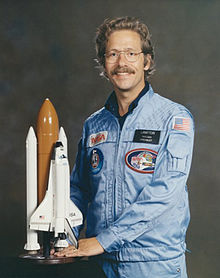Michael Lampton
Michael L. Lampton | |
|---|---|
 | |
| Born | March 1, 1941 Williamsport, Pennsylvania, U.S. |
| Nationality | American |
| Occupation | Physicist, Space Sciences Laboratory |
| Space career | |
| UC Berkeley Payload Specialist | |
| Missions | STS-9, STS-45 |
Mission insignia | |
Michael Logan Lampton (born March 1, 1941) is an American astronaut, founder of the optical ray tracing company Stellar Software, and known for his paper on electroacoustics with Susan M Lea, The theory of maximally flat loudspeaker systems.[1]
Personal[]
Lampton was born March 1, 1941 in Williamsport, Pennsylvania.[2] He is married to San Francisco State University physicist, Dr. Susan M. Lea, with whom he has one daughter, Jennifer Lea Lampton.[3]
Education[]
- Bachelor of Science degree in Physics from Caltech, 1962
- Ph.D. in Physics from the University of California-Berkeley, 1967
SNAP Project[]
Lampton has been heavily involved with the SNAP project.[4] SNAP, the Supernova/Acceleration Probe, will study exploding stars called supernovae, as well as the gentle smearing of the light from distant galaxies due to gravity — called weak gravitational lensing — and put limits on what may or may not be the force driving the outward pull on the Universe. SNAP will investigate over one thousand square degrees of sky with a 500 megapixel camera.[5]
SNAP is part of the Joint Dark Energy Mission (JDEM), which is a cooperative venture between NASA and the U.S. Department of Energy. SNAP collaborators John Mather and George Smoot were awarded the 2006 Nobel prize in physics.[6]
Career with NASA[]
Lampton was a NASA payload specialist from 1978 to 1992.[2] Below is a list of the missions he was a part of.
| Year | Mission | Position |
|---|---|---|
| 1983 | STS-9/Columbia | selected and served as backup payload specialist[7] |
| 1985 | STS-51-H/Spacelab EOM 1 mission | selected as payload specialist (mission cancelled after the technical problems) |
| 1986 | STS-61-K/Spacelab EOM 1-2 mission | selected as payload specialist (mission cancelled after the Challenger accident)[8] |
| 1989 | STS-45/ATLAS-1 | selected as payload specialist (the same mission as STS-61K—but renamed), replaced by backup payload specialist Dirk Frimout due to medical problems [9] |
Pranks[]
In 1961, while Lampton was attending Caltech he was one of the "Fiendish Fourteen", 14 students responsible for the Great Rose Bowl Hoax.
References[]
- ^ Lea, S.; Lampton, M. (1972). "The theory of maximally flat loudspeaker systems". IEEE Transactions on Audio and Electroacoustics. ieeexplore.ieee.org. 20 (3): 200–203. doi:10.1109/TAU.1972.1162374.
- ^ Jump up to: a b Joachim Becker. "Astronaut Biography: Michael Lampton". spacefacts.de. Retrieved 2016-07-22.
- ^ http://www.physics.sfsu.edu/~lea/bio.html
- ^ Lampton, M; Collaboration, SNAP (2002). "[astro-ph/0209549] The SNAP Telescope". arXiv:astro-ph/0209549.
- ^ "Archived copy". Archived from the original on 2013-07-03. Retrieved 2013-07-03.CS1 maint: archived copy as title (link)
- ^ "The Nobel Prize in Physics 2006". nobelprize.org. Retrieved 2016-07-22.
- ^ "home/hqnews/1990/90-072". nasa.gov. Retrieved 2016-07-22.
- ^ "flights/sts61k". astronautix.com. Retrieved 2016-07-22.
- ^ "NASA - ATLAS-1: The First Atmospheric Laboratory for Applications and Science". nasa.gov. Retrieved 2016-07-22.
- 1941 births
- Living people
- American astronauts
- University of California, Berkeley alumni
- California Institute of Technology alumni